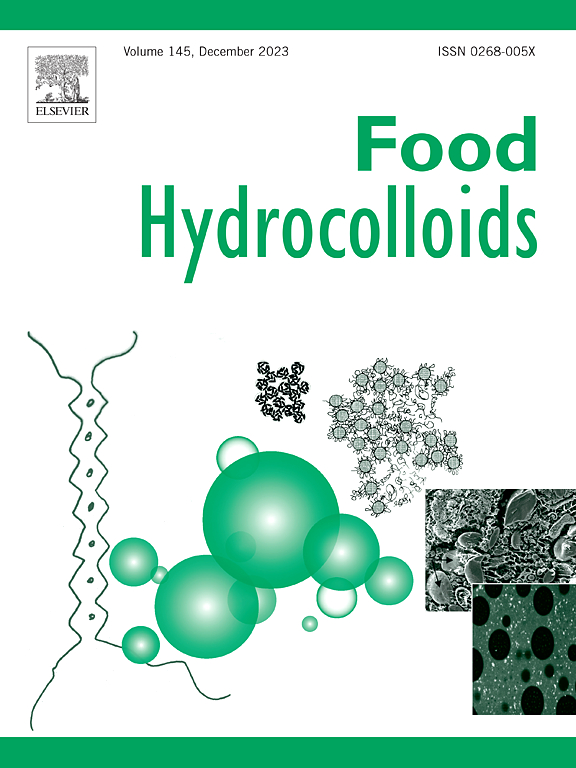Effects of different exogenous proteins on rice starch retrogradation behavior and their potential mechanisms
IF 11
1区 农林科学
Q1 CHEMISTRY, APPLIED
引用次数: 0
Abstract
Retarding starch retrogradation is essential for developing food products with desirable qualities. The inhibitory effects of three proteins on rice starch (RS) retrogradation, as well as the effects of soybean isolate protein (SPI), pea isolate protein (PPI) and whey isolate protein (WPI) through competitive hydration related to the content of polar amino acids (WPI > PPI > SPI:66 % > 64 %>61 %), have been systematically revealed by using multiscale characterization techniques; a molecular weight-dependent physical barrier effect (The molecular weight of WPI is small and distributed between 10 and 70 kDa); the formation of rice amyloid protein V complexes and competitive hydration advantages and high solubility properties of WPI through hydrogen bonding and hydrophobic interactions were the most effective in inhibiting the short-range ordered structures (6.00 %, 7.04 %) and the long-range crystalline network (16.79 % after 1 day and 7 days, respectively and 24.62 %) were most effective. In contrast, SPI, with the largest molecular weight but higher content of hydrophobic groups, had a better complex-binding ability than PPI, which resulted in a hierarchical relationship of inhibition effect of WPI > SPI > PPI. The concentration effect study showed that the inhibition of rice starch retrogradation by the proteins was positively correlated with the amount of protein added, but the synergistic effect tended to saturate once the protein concentration exceeded 15 %. This study explored the mechanisms by which three common exogenous proteins prevent rice starch retrogradation, offering a theoretical foundation for using plant or animal proteins to control the texture and shelf-life of starch-based foods.

不同外源蛋白对水稻淀粉降解行为的影响及其潜在机制
延缓淀粉的降解对于开发具有理想品质的食品是必不可少的。研究了3种蛋白对大米淀粉(RS)降解的抑制作用,以及大豆分离蛋白(SPI)、豌豆分离蛋白(PPI)和乳清分离蛋白(WPI)通过与极性氨基酸(WPI >;PPI在SPI: 66% >;64% > 61%),通过使用多尺度表征技术系统地揭示;分子量依赖的物理屏障效应(WPI分子量较小,分布在10 - 70 kDa之间);水稻淀粉样蛋白V络合物的形成以及WPI通过氢键和疏水相互作用的竞争性水化优势和高溶解度对近程有序结构(6.00%,7.04%)和远程晶体网络(1 d和7 d后分别为16.79%和24.62%)的抑制效果最好。相比之下,SPI分子量最大,但疏水性基团含量较高,其复合物结合能力优于PPI,这导致WPI的抑制效果呈层次关系;SPI祝辞PPI。浓度效应研究表明,蛋白质对大米淀粉降解的抑制作用与蛋白质添加量呈正相关,但当蛋白质浓度超过15%时,协同效应趋于饱和。本研究探讨了三种常见外源蛋白对大米淀粉降解的抑制机制,为利用植物或动物蛋白控制淀粉类食品的质地和保质期提供了理论基础。
本文章由计算机程序翻译,如有差异,请以英文原文为准。
求助全文
约1分钟内获得全文
求助全文
来源期刊

Food Hydrocolloids
工程技术-食品科技
CiteScore
19.90
自引率
14.00%
发文量
871
审稿时长
37 days
期刊介绍:
Food Hydrocolloids publishes original and innovative research focused on the characterization, functional properties, and applications of hydrocolloid materials used in food products. These hydrocolloids, defined as polysaccharides and proteins of commercial importance, are added to control aspects such as texture, stability, rheology, and sensory properties. The research's primary emphasis should be on the hydrocolloids themselves, with thorough descriptions of their source, nature, and physicochemical characteristics. Manuscripts are expected to clearly outline specific aims and objectives, include a fundamental discussion of research findings at the molecular level, and address the significance of the results. Studies on hydrocolloids in complex formulations should concentrate on their overall properties and mechanisms of action, while simple formulation development studies may not be considered for publication.
The main areas of interest are:
-Chemical and physicochemical characterisation
Thermal properties including glass transitions and conformational changes-
Rheological properties including viscosity, viscoelastic properties and gelation behaviour-
The influence on organoleptic properties-
Interfacial properties including stabilisation of dispersions, emulsions and foams-
Film forming properties with application to edible films and active packaging-
Encapsulation and controlled release of active compounds-
The influence on health including their role as dietary fibre-
Manipulation of hydrocolloid structure and functionality through chemical, biochemical and physical processes-
New hydrocolloids and hydrocolloid sources of commercial potential.
The Journal also publishes Review articles that provide an overview of the latest developments in topics of specific interest to researchers in this field of activity.
 求助内容:
求助内容: 应助结果提醒方式:
应助结果提醒方式:


